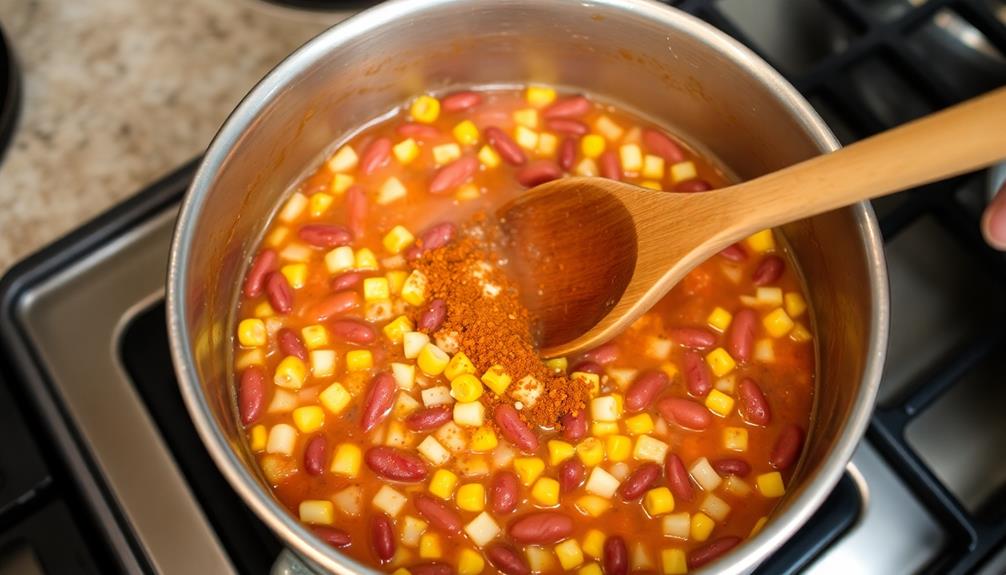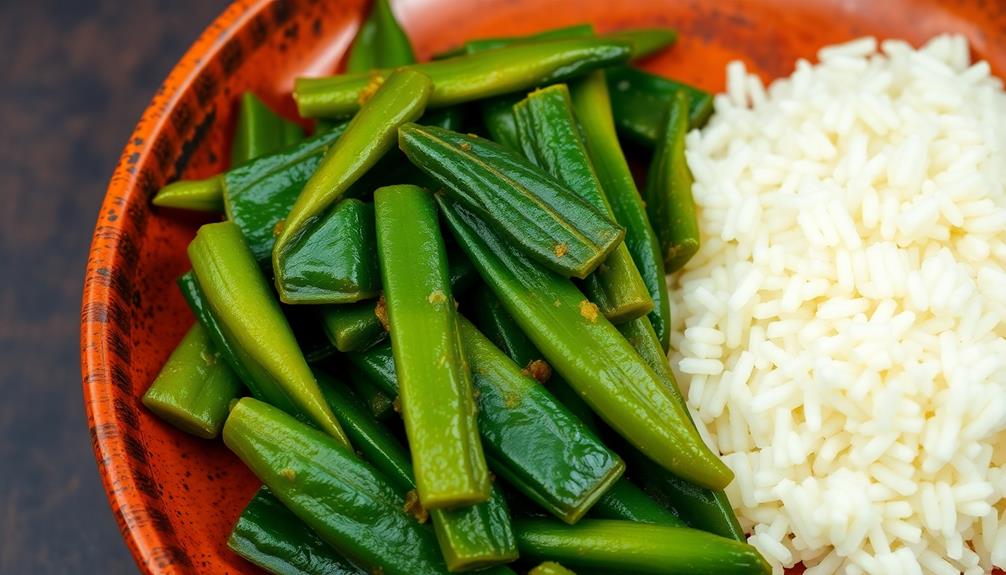Githeri, a beloved Kenyan classic, combines the hearty flavors of boiled maize and beans. This nutritious dish has rich cultural significance, often shared during special occasions and celebrations. It provides a balanced source of carbohydrates, protein, and fiber, making it a heart-healthy option. The recipe is adaptable, allowing you to customize it with your favorite spices and veggies. Githeri represents the spirit of togetherness in Kenyan culture, and you'll find it's a wonderful way to enjoy a taste of this vibrant culinary heritage. Keep reading to uncover the full Githeri recipe and learn more about its captivating history.
Key Takeaways
- Githeri is a traditional Kenyan dish with rich cultural significance, originating from the Kikuyu people and often served during special occasions.
- The dish is nutritionally balanced, providing carbohydrates, protein, and fiber, making it a heart-healthy option.
- The recipe combines boiled maize and beans, with regional and familial variations, and can be customized with additional ingredients.
- The cooking process involves soaking the dried corn and beans overnight, followed by boiling and seasoning.
- Githeri is typically served hot, often accompanied by avocado, and can be enjoyed as a main dish or side dish.
History

Githeri is a traditional Kenyan dish with a rich history. It's a hearty, comforting meal that's been enjoyed for generations, and it's become a beloved part of Kenyan culture.
The dish's origins can be traced back to the Kikuyu people, who'd mix boiled maize and beans as a simple, nutritious meal. Over time, githeri has evolved, with various regions and families adding their own unique twists and flavors.
Today, githeri is a staple in Kenyan households, often served during special occasions and celebrations. The combination of maize and beans provides a balanced source of carbohydrates, protein, and fiber, making it a wholesome and satisfying dish.
Whether you're enjoying it as a main course or as a side, githeri is a true taste of Kenyan heritage. Its enduring popularity is a testament to the rich culinary traditions that have been passed down through the generations.
Recipe

Githeri is a traditional Kenyan dish made from a combination of maize (corn) and beans. It's a hearty and nutritious meal that has been a staple in Kenyan cuisine for generations.
The recipe is simple and versatile, allowing for variations based on personal preferences or available ingredients. Githeri can be served as a main dish or as a side accompaniment to other Kenyan dishes.
Ingredients:
- 1 cup dried white beans, soaked overnight and drained
- 1 cup dried maize kernels (or 2 cups fresh or canned corn kernels)
- 1 onion, diced
- 2 tomatoes, diced
- 2 cloves garlic, minced
- 1 teaspoon cumin
- 1 teaspoon paprika
- Salt and pepper to taste
- 2 cups water or vegetable broth
In a large pot, combine the soaked and drained beans and the maize kernels. Add the diced onion, tomatoes, garlic, cumin, paprika, and salt and pepper to taste.
Pour in the water or vegetable broth and bring the mixture to a boil. Reduce the heat to low, cover the pot, and simmer for 45 to 60 minutes, or until the beans and maize are tender.
Githeri is best served hot, but it can also be enjoyed at room temperature. The dish can be further enhanced by garnishing it with fresh herbs, such as cilantro or parsley, or by serving it with a side of avocado or a dollop of sour cream.
Cooking Steps

Soak the dried corn and beans overnight to soften them up.
Drain and rinse the soaked ingredients, then add chopped onions and tomatoes.
Bring the mixture to a boil, then let it simmer until everything's cooked through.
Season it to your liking, and you're all set!
Step 1. Soak Dried Corn and Beans Overnight

Before you start cooking the githeri, it's important to properly prepare the dried corn and beans. First, you'll want to give them a good soak overnight. Simply place the corn and beans in a large bowl, then cover them with plenty of water. Let them sit at room temperature for 8 to 12 hours. This helps soften the tough outer shells, making them easier to cook.
Once the soaking time is up, drain and rinse the corn and beans. They should have expanded in size and feel much more tender.
Now you're ready to move on to the next step – cooking the githeri! Grab your pot and let's get started. The soaked corn and beans will cook up nice and soft, making for a heartwarming and satisfying dish.
Get excited, because this traditional Kenyan meal is about to become a new family favorite.
Step 2. Drain and Rinse Soaked Ingredients

After the soaking time is up, be sure to drain and thoroughly rinse the corn and beans. This step is crucial to remove any dirt or impurities that may have accumulated during the soaking process.
Carefully pour the contents of the pot through a colander, allowing the water to drain away. Then, run fresh, cool water over the corn and beans, giving them a gentle swish to dislodge any remaining debris.
This extra rinsing will ensure your githeri is squeaky clean and ready to cook.
Once drained and rinsed, the corn and beans are prepped and primed for the next step in the recipe. Get excited, because now you're one step closer to enjoying the delicious, hearty flavors of traditional Kenyan githeri!
With just a few more simple tasks, you'll have a steaming, savory pot of this beloved dish to share with your family and friends.
Step 3. Add Chopped Onions and Tomatoes

Next, add the chopped onions and tomatoes to the pot. Watch as they sizzle and release their delightful aromas!
Stir the veggies until they're softened and coated in the flavors of the simmering beans and corn. Breathe in the mouth-watering scent – it's making your stomach rumble with anticipation, isn't it?
The onions will add a lovely sweetness, while the juicy tomatoes will lend a touch of acidity to balance out the dish. Gently fold everything together, ensuring the flavors meld perfectly.
This step is crucial for building the foundation of your authentic Githeri. Soon, the vibrant colors and irresistible aroma will have everyone in the kitchen eagerly waiting to dive in.
Get ready, because the best is yet to come! With the onions and tomatoes now incorporated, you're one step closer to enjoying a hearty, homemade Githeri feast.
Step 4. Bring to a Boil, Then Simmer

Once the onions and tomatoes have been incorporated, bring the mixture to a boil over medium-high heat. You'll know it's ready when you see those bubbles start to surface and the ingredients meld together into a delicious-smelling stew.
Now, reduce the heat to low and let it simmer gently for 15-20 minutes. This allows the flavors to really develop and the beans or maize to become nice and tender.
As the githeri simmers, keep an eye on it, giving it a stir every now and then. You want to make sure nothing sticks to the bottom of the pot.
The slow, gentle heat will turn this simple dish into a hearty, comforting meal. Get ready for your kitchen to be filled with the mouthwatering aroma of spices and simmering veggies. Your family will be eagerly awaiting their bowls of this Kenyan classic!
Step 5. Season to Taste

Seasoning the githeri to perfection is key to unlocking its true flavor. Grab a pinch of salt and sprinkle it over the simmering pot, stirring gently to distribute it evenly. The aroma of the salt will instantly elevate the dish, bringing out the natural sweetness of the corn and beans.
Next, add a dash of black pepper. This zesty seasoning will add a subtle kick, complementing the other flavors beautifully. Don't be afraid to add a little more if you want a bolder taste.
For an extra burst of flavor, consider throwing in some dried herbs, like thyme or rosemary. Their earthy notes will infuse the githeri with warmth and complexity. Stir them in and let the aromas fill your kitchen.
Lastly, a squeeze of fresh lemon juice can brighten the dish, providing a refreshing contrast to the hearty ingredients. Start with a small amount and taste as you go, adjusting the seasoning to suit your personal preferences.
Final Thoughts

With githeri being a versatile and nutritious dish, you can feel confident in its ability to satisfy your hunger and provide essential nutrients.
Whether you're looking for a comforting meal or a way to incorporate more plant-based proteins into your diet, this classic Kenyan dish is sure to become a staple in your culinary repertoire. Just like the beloved classic Thanksgiving side dish corn on the cob, githeri can be tailored to suit various tastes and preferences.
The best part about githeri is its versatility – you can customize it to suit your taste preferences and dietary needs.
Add your favorite spices, herbs, or vegetables to create a dish that's truly your own. And don't forget the opportunity to get the whole family involved in the cooking process, making it a fun and interactive activity.
As you savor each bite of this heartwarming meal, you'll be transported to the vibrant culture and flavors of Kenya.
Githeri isn't just a dish – it's a celebration of community, tradition, and the joy of sharing a delicious meal together.
Frequently Asked Questions
What Are the Health Benefits of Eating Githeri?
Eating githeri provides numerous health benefits. It's a nutritious dish packed with protein, complex carbohydrates, and essential vitamins and minerals. Incorporating it into your diet can support overall health, boost energy levels, and promote better digestion.
How Can I Make Githeri More Flavorful?
To make your githeri more flavorful, try sautéing onions, garlic, and spices like cumin or curry powder before adding the beans and corn. You can also garnish with fresh cilantro, lemon juice, or a dollop of plain yogurt.
Is Githeri Suitable for Vegetarians or Vegans?
Yes, githeri is suitable for vegetarians and vegans. The traditional dish is made with just boiled maize and beans, making it a plant-based, protein-rich meal that can be easily adapted to fit a vegetarian or vegan diet.
Can I Freeze Leftover Githeri for Later Use?
Yes, you can freeze leftover githeri for later use. Just store it in an airtight container or freezer bag, and it'll keep for up to 3 months. When you're ready to enjoy it, simply thaw and reheat the githeri.
What Are Some Unique Variations of the Traditional Githeri Recipe?
You can jazz up the traditional githeri recipe by adding spices like cumin or chili powder, incorporating vegetables like kale or spinach, or blending in some coconut milk for a creamy twist. Get creative with your githeri!










